RAF Bovingdon - 1960s
' A huge bit of Countryside spoilt '

41-9154 'Bat Outa Hell' September 4th 1942 - Strawberry Wood beyond. (Roger Freeman)
I'm reading a book called ' Seventy Summers' written by Tony Harman and published by the BBC in 1986 to coincide with a documentary series of the same name. Mr Harman farmed at Whelpley Hill and has written a very entertaining account of his life in that area of the Chilterns. He writes very little of the aerodrome apart from having been mistakenly detained by the American Police on the base one night during the war when his car was 'borrowed' by a couple of blokes. The quote ' A huge bit of countryside spoilt ' in regard to the aerodrome is his. (In retrospect he displays regret at his own hedge removal operations). Looking at the aerial photo of the airfield which Jumpseater posted and the section of Ordnance Survey that XV490 displayed one can see a distinctive pattern of what we today would consider to be smallish fields. These date back to the 16th century, nearly all are named from that time with two or three being sufficient for a farmer or peasant to make a living from. They were all heavily hedged which included trees and remained in that way up until the 1920s when the hedges started to be thinned out. With the availability of Bulldozers during and after the war the removal of hedges and the formation of larger fields gathered pace. The Government, having paid farmers to remove hedges in the 20th century, are now in the 21st century paying farmers to restore them.
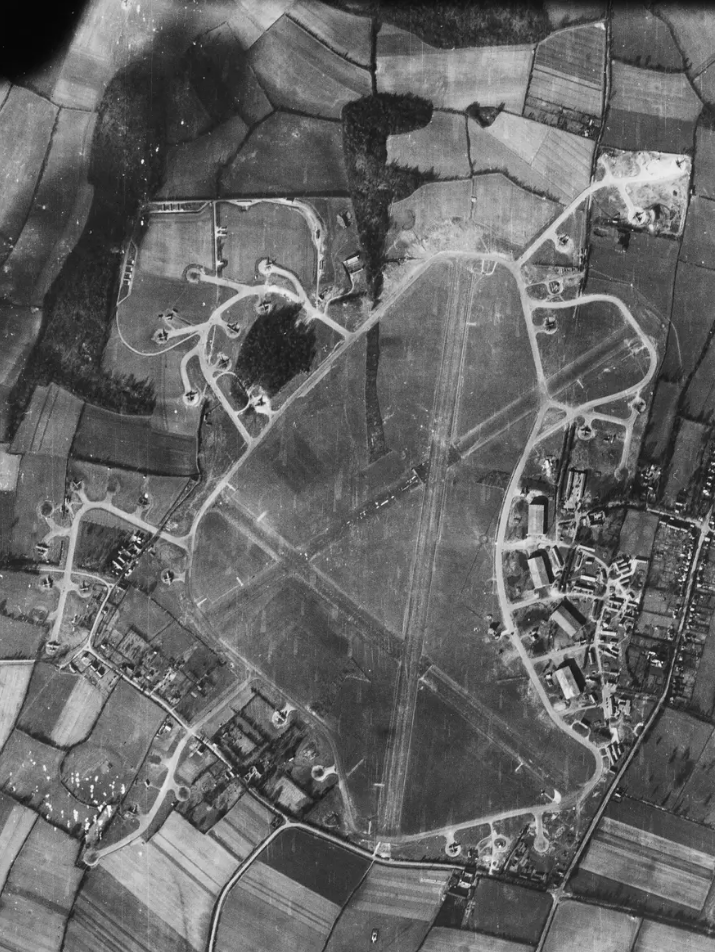
English Heritage (1944)
Spot the late Bronze - early Iron Age Fort. By comparing the field patterns and woods above with those of the Ordnance Survey of 1899 you can trace the outline of the aerodrome.

Berry Farm is here named Whelpleyhill Farm
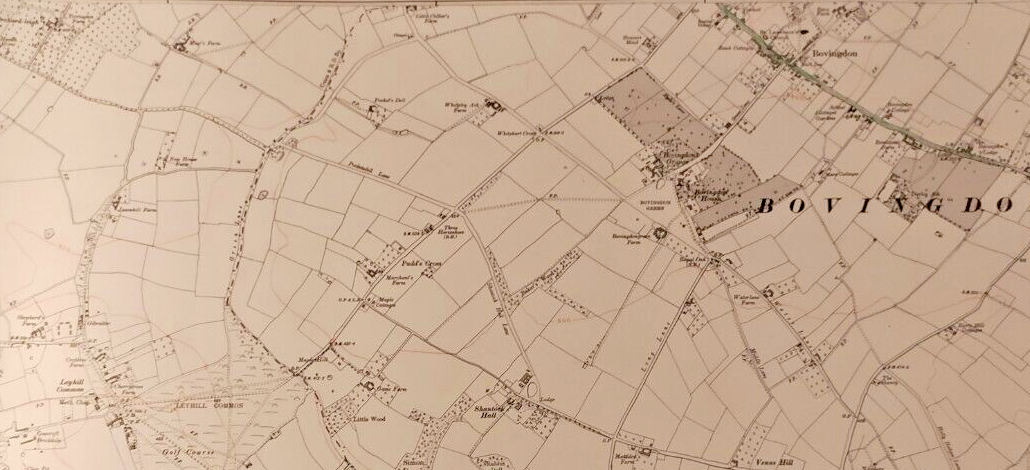
Apologies for indistinct print.......

Strawberry Wood - Photo by P.S. Parrot
Last edited by OUAQUKGF Ops; 4th Feb 2024 at 08:53. Reason: Tidying Up
I've made these screenshots from XV490's interesting post #640 about the tests on the effects of aircraft noise on covert operations at Latimer House.


The aerial photograph below can be found way back in this thread somewhere. What I have noticed now is the date that the recce was made by the RAF which was 6th May 1942. I suspect specifically in connection with the planned flight by the Halifax to Bovingdon the following day..........?

Note unfinished state - threshold R/W 04 and typically several dispersals at Whelpley Hill still to be constructed, runways not marked. American Air Museum in Britain.

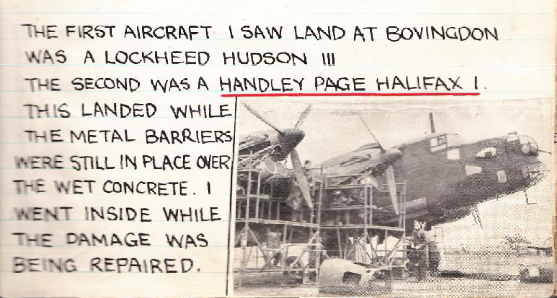
Extract from John Young's Diary as quoted by XV490 with thanks to the compiler of the Diary/ PDF Keith Fletcher. As the link to John Young's Diary is hidden in the depths of this thread it may help to display it here:https://www.cheshamgolf.co.uk/wp-con...John-Young.pdf


The aerial photograph below can be found way back in this thread somewhere. What I have noticed now is the date that the recce was made by the RAF which was 6th May 1942. I suspect specifically in connection with the planned flight by the Halifax to Bovingdon the following day..........?

Note unfinished state - threshold R/W 04 and typically several dispersals at Whelpley Hill still to be constructed, runways not marked. American Air Museum in Britain.


Extract from John Young's Diary as quoted by XV490 with thanks to the compiler of the Diary/ PDF Keith Fletcher. As the link to John Young's Diary is hidden in the depths of this thread it may help to display it here:https://www.cheshamgolf.co.uk/wp-con...John-Young.pdf
Last edited by OUAQUKGF Ops; 4th Feb 2024 at 12:46.
The following users liked this post:
Latimer House War Office Papers WO208/3456
The tests on the effects of aircraft noise at Latimer House took place in May 1942, supervised by the research branch of the General Post Office (GPO; later British Telecom/BT) – which had overseen the recording equipment at the site.
On May 7th, a Halifax Mk I, which was to provide the noise source, hit obstructions while landing at Bovingdon, as confirmed by https://www.cheshamgolf.co.uk/wp-content/uploads/2020/02/Bovingdon-Airfield-by-John-Young.pdf]John Young, who wrote: “This landed while the metal barriers were still in place over the wet concrete.”
John later climbed inside the bomber while it was being repaired.Two days later it took off to fly several passes over Latimer House at different heights.
The GPO report dated May 9th, 1942 described the background and the flight tests:
Tests of interfering effects of Aircraft Noise
About six months ago it was realised that an aerodrome was in course of construction at Bovingdon, some 2½ miles from the P/W camp at Latimer, and it was feared that aircraft might cause serious interference with the listening work.
A series of tests was accordingly arranged for Thursday, 7th May, when a Halifax bomber was to fly over the camp at various heights to be arranged with the pilot on that morning.
The War Office proposed that experienced officers should listen on the equipment while the aircraft was flying overhead and express an opinion as to the magnitude of the interfering effect.
Experience has shown, however, that opinions of this kind are of very doubtful utility and it was decided to carry out articulation tests.
Since it was not possible on security grounds to take experienced testing crews to the camp, recording of logatoms [meaningless words] were made and these would be reproduced on high quality equipment in two of the cells under various conditions of window opening.
The sounds received in the listening rooms were to be recorded and the records thus made sent for transcription by expert Intelligence Officers.
By this means it was hoped that an analysis of the errors would provide some measure of the interfering effect of the aircraft which would independent of personal opinions and prejudices.
Everything was ready for the tests at 10 o'clock on Thursday morning when the pilot of the aircraft was due at the preliminary conference. At 12 o'clock news was received that the aircraft had been damaged by anti-aircraft obstacles when landing at Bovingdon aerodrome.
It transpired that the Department of the Air Ministry providing the aircraft had not contacted the Department of the Air Ministry building the aerodrome and ascertained that the latter was usable!
No standard marking to indicate that the aerodrome was unfit for service was displayed at Bovingdon and the pilot had been unable to see the obstruction until touching down. As the aircraft was too badly damaged to take off again immediately, it was only possible to arrange a programme with the pilot which was to be carried out on Saturday morning.
The programme was as follows. The aircraft would fly over the camp at 1000', 2000', 4000' and 6000' on a specified course, starting about four miles on one side and finishing five or six miles on the other [ ... ]
The weather conditions were perfect to-day and the tests were carried out satisfactorily. Some modification was necessary as the effect of the aircraft noise was considerably less than had been anticipated and, instead of carrying out the last test at 6000', this was altered to 500'. The records have been sent for transcription and on return will be analysed.
On May 7th, a Halifax Mk I, which was to provide the noise source, hit obstructions while landing at Bovingdon, as confirmed by https://www.cheshamgolf.co.uk/wp-content/uploads/2020/02/Bovingdon-Airfield-by-John-Young.pdf]John Young, who wrote: “This landed while the metal barriers were still in place over the wet concrete.”
John later climbed inside the bomber while it was being repaired.Two days later it took off to fly several passes over Latimer House at different heights.
___________
The GPO report dated May 9th, 1942 described the background and the flight tests:
Tests of interfering effects of Aircraft Noise
About six months ago it was realised that an aerodrome was in course of construction at Bovingdon, some 2½ miles from the P/W camp at Latimer, and it was feared that aircraft might cause serious interference with the listening work.
A series of tests was accordingly arranged for Thursday, 7th May, when a Halifax bomber was to fly over the camp at various heights to be arranged with the pilot on that morning.
The War Office proposed that experienced officers should listen on the equipment while the aircraft was flying overhead and express an opinion as to the magnitude of the interfering effect.
Experience has shown, however, that opinions of this kind are of very doubtful utility and it was decided to carry out articulation tests.
Since it was not possible on security grounds to take experienced testing crews to the camp, recording of logatoms [meaningless words] were made and these would be reproduced on high quality equipment in two of the cells under various conditions of window opening.
The sounds received in the listening rooms were to be recorded and the records thus made sent for transcription by expert Intelligence Officers.
By this means it was hoped that an analysis of the errors would provide some measure of the interfering effect of the aircraft which would independent of personal opinions and prejudices.
Everything was ready for the tests at 10 o'clock on Thursday morning when the pilot of the aircraft was due at the preliminary conference. At 12 o'clock news was received that the aircraft had been damaged by anti-aircraft obstacles when landing at Bovingdon aerodrome.
It transpired that the Department of the Air Ministry providing the aircraft had not contacted the Department of the Air Ministry building the aerodrome and ascertained that the latter was usable!
No standard marking to indicate that the aerodrome was unfit for service was displayed at Bovingdon and the pilot had been unable to see the obstruction until touching down. As the aircraft was too badly damaged to take off again immediately, it was only possible to arrange a programme with the pilot which was to be carried out on Saturday morning.
The programme was as follows. The aircraft would fly over the camp at 1000', 2000', 4000' and 6000' on a specified course, starting about four miles on one side and finishing five or six miles on the other [ ... ]
The weather conditions were perfect to-day and the tests were carried out satisfactorily. Some modification was necessary as the effect of the aircraft noise was considerably less than had been anticipated and, instead of carrying out the last test at 6000', this was altered to 500'. The records have been sent for transcription and on return will be analysed.
___________
It is reasonable to assume that, despite earlier misgivings, MI6 and the GPO then gave the green light for unrestricted flying from Bovingdon, although the airfield's size may have curtailed by the orders issued by the War Office in October 1941.
(Image Amersham Museum)
In June 1941 the C.S.D.I.C. became much exercised by the presence nearby of Bovingdon Aerodrome then under construction, of which the Director of Military Intelligence had not been made aware when the decision was made to move part of their eavesdropping operations to Latimer House.* With the perceived threat of aircraft noise interfering with covert listening a fairly concentrated campaign was then mounted by the intelligence services to curtail operations at Bovingdon Aerodrome altogether or allow only 'ground training' whatever that may have meant. At one stage when M.I.19 could be said to have been on their back foot over the matter, they investigated the availability of alternative suitable premises which were not easily had and that factor combined with the already very large expenditure made on extensive alterations at Latimer meant that the idea was abandoned. It appears that M.I.19 did succeed in stopping the construction of an aerodrome at Holtspur near Beaconsfield which would have interfered with their listening operations at Wilton Park.
*' The proposal to construct an aerodrome at Bovingdon was referred to the War Office in February, 1941. The War Office raised no objection. Unfortunately the Director of Military Intelligence, who is responsible for the Centre's administration, was not consulted.' (Note for V.C.I.G.S.)
(C.S.D.I.C. = Combined Services Detailed Interrogation Centre). I've transcribed a few pages from the relevant War Office File concerning Latimer House and its relationship with Bovingdon Aerodrome.

Above letter 26th June 1941 from AVM Charles Medhurst (Assistant Chief of the Air Staff (Intelligence) to Major General Francis Davidson, Director Military Intelligence.

Above Draft Letter from Major General Davidson (D.M.I.) to Vice Chiefs Imperial General Staff 17th October 1941.
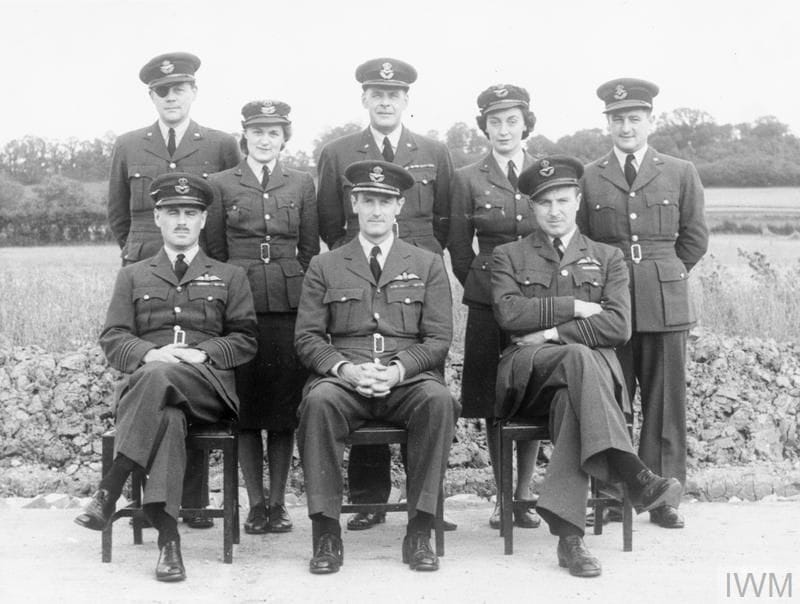

(Imperial War Museum)
Group Captain Archibald MacDonald (d1947) - tasked to 'Provide the heaviest possible Bomber' for the Latimer Tests. Perhaps the mission was flown by a Halifax 11 of 138 Special Duties Squadron ? A piece of cake for them. Incidentally both 138 and 161 Special Duties Squadrons (SOE) were controlled by AVM Charles Medhurst, ACAS (I) who was only too aware of the spat between Latimer House and the Air Ministry.
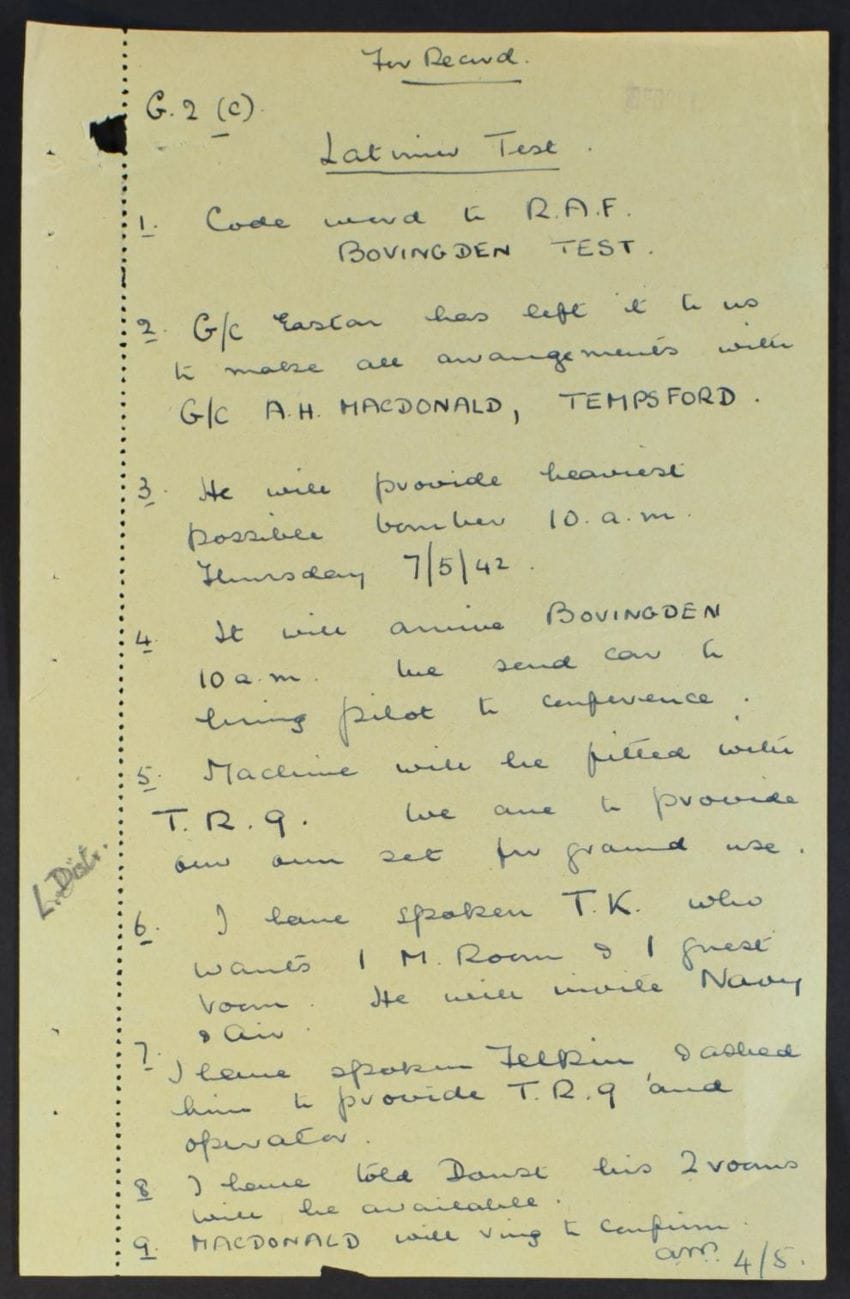
WO208/3456 NA The above bit of scrap, notes on preparations for tests on May 7th 1942 which were scrubbed after minor damage to the Halifax was sustained on landing at Bovingdon. Following repair of the Halifax the tests were flown on May 9th 1942. ( TK was Colonel Thomas Kendrick, MI6 Spymaster and overall Commandant of C.S.D.I.C. Mr Doust was the Senior GPO Research Engineer in charge of the tests.).
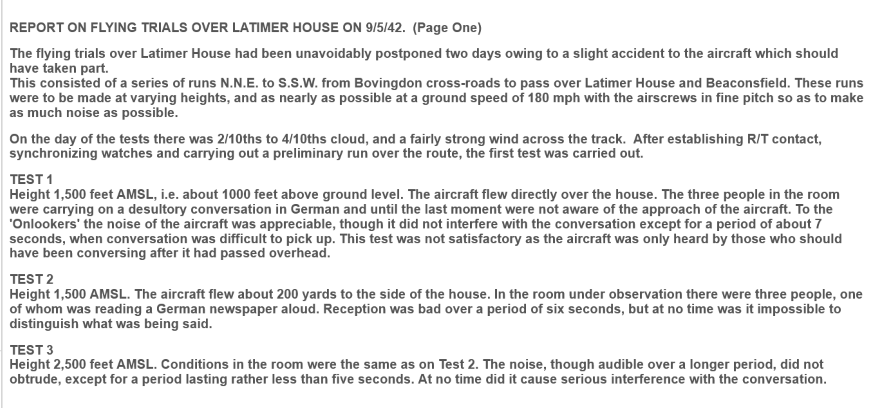

Submitted 10th May 1942 by Wing Commander S.D. Felkin Commanding Officer ADI9 (K) - Air Intelligence to A.C.A.S. (I) Air Ministry copy Lt Col Rawlinson M.I.19, War Office.

Correction read C.S.D.I.C.
Above signed by Doust from the GPO Research Branch, 29th September 1942 to D.M.I. (M.I. 19) and C.S.D.I.C.
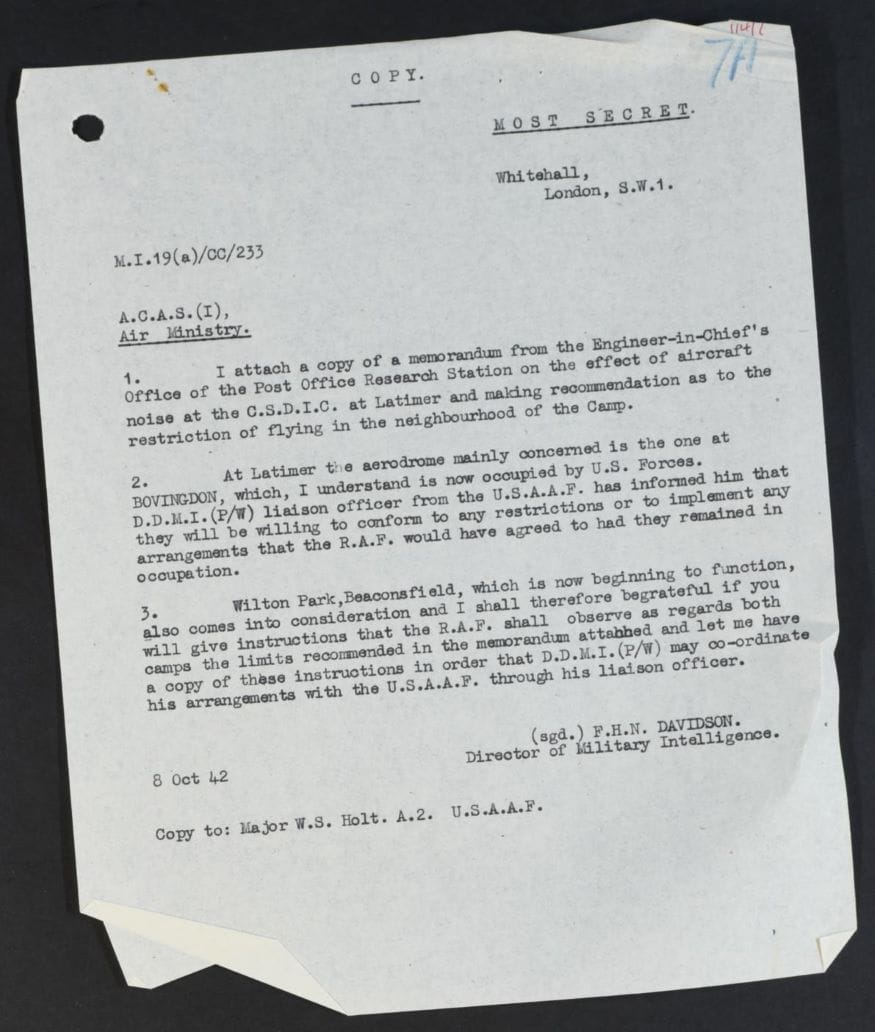
WO208/3456 NA.

For Your Eyes Only - extracted from WO208/3456 NA
Many thanks to XV490 for his invaluable contribution !
Last edited by OUAQUKGF Ops; 19th Feb 2024 at 21:59. Reason: Image Added
Accident Doulas C-47A 42-92056 Bovingdon 18th April 1946
This aircraft was serving with 324 TC Squadron European Air Transport Service based at Bovingdon. The sortie was an Air Test following the replacement of Diamond Flying Control Chains. Post accident examination of these chains revealed no defects. The aircraft was crewed by two young and experienced C-47 pilots. I've illustrated a Diamond Control Chain below for those of you (myself included) who have never heard of them before now. I apologize for the fuzzy quality of some of these old documents.

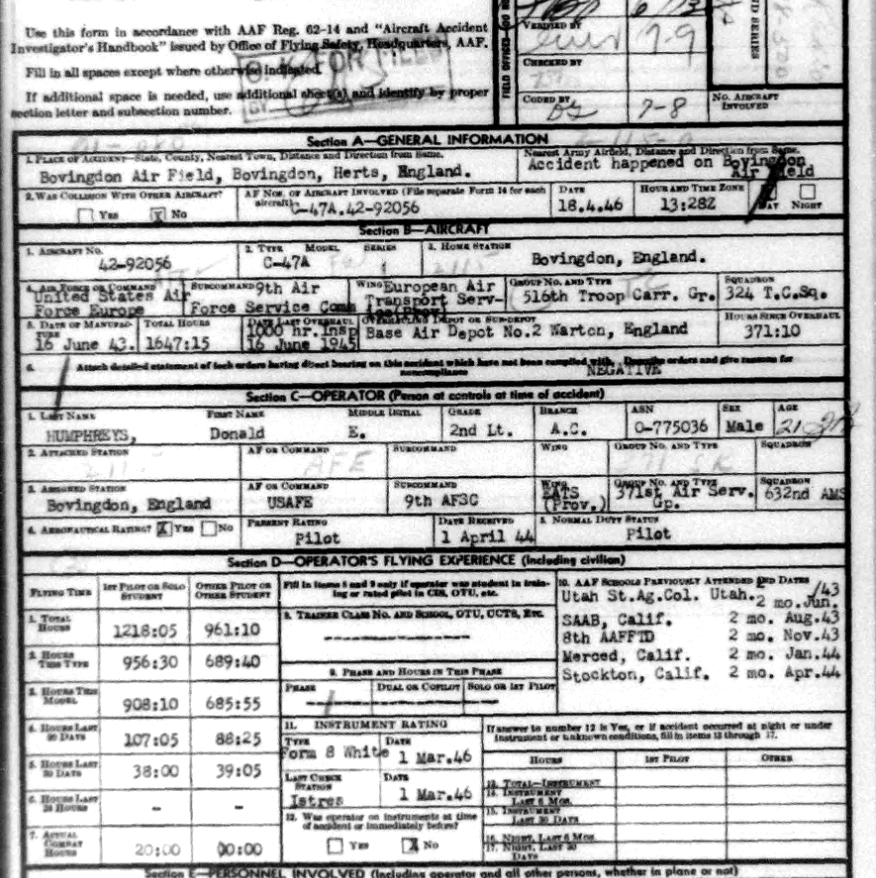

From the ATC Witness Statement I've assumed (but cannot be sure) that the C-47 commenced its take-off run on R/W 22 from the intersection with R/W 27 which would have given them approximately 3000 ft of runway. It would seem to have been a flap-less take-off which is not uncommon on the C-47. There was a tail-wind of 12 mph.which appears to be of no significance to the investigators.
I've scaled and marked the two impact points where the starboard wing contacted the ground. (A very poor quality sketch map was made on the spot but will not reproduce well).
There were quite a few witnesses - all in an area around the hangars and pan north-east of the Control Tower which I've marked in green.
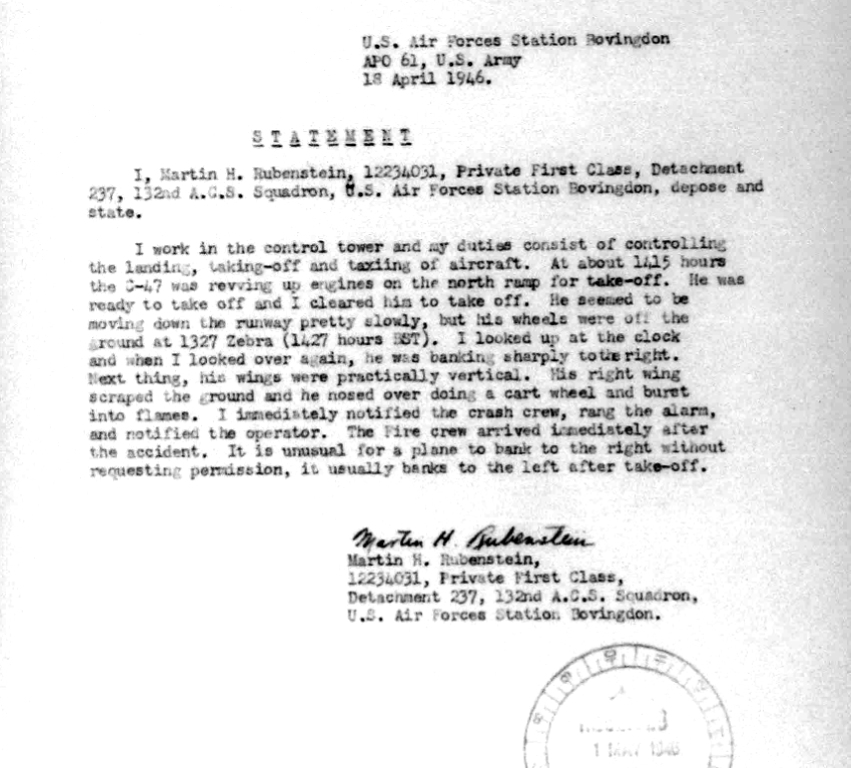
The Controller remarks that the aircraft appeared to be moving down the the runway pretty slowly - this observation is echoed by another witness. However it could be that they were more accustomed to seeing C-47s moving more rapidly at that point because those aircraft would have commenced take off at the start of R/W 22 and not, as I've assumed in this case, from the intersection.
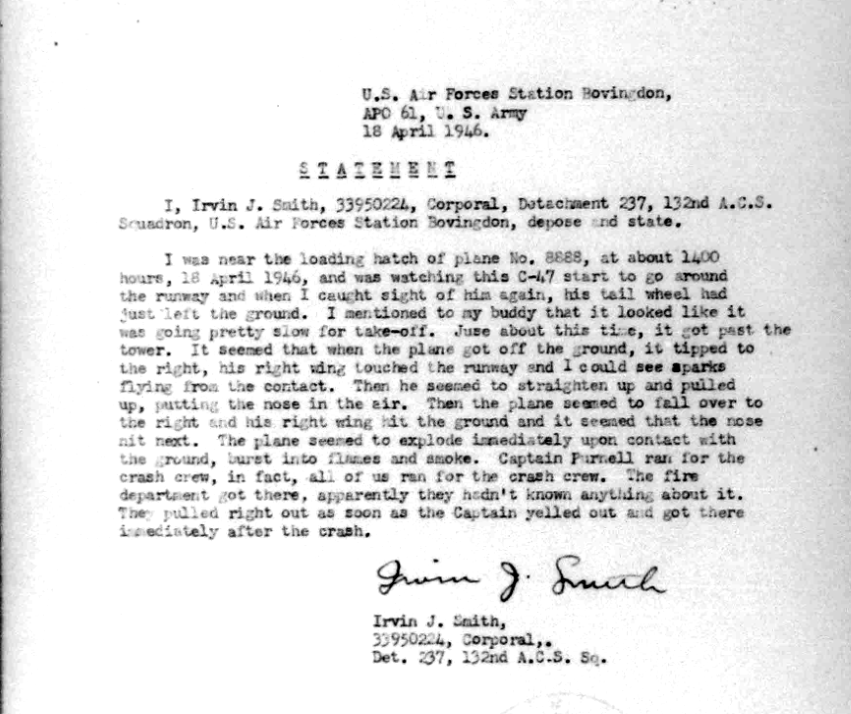
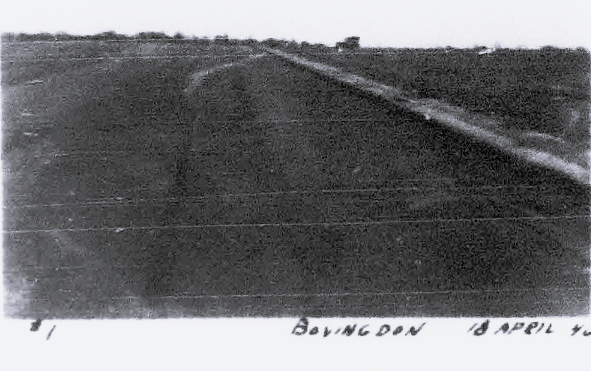
First Impact Point


Second Impact Point


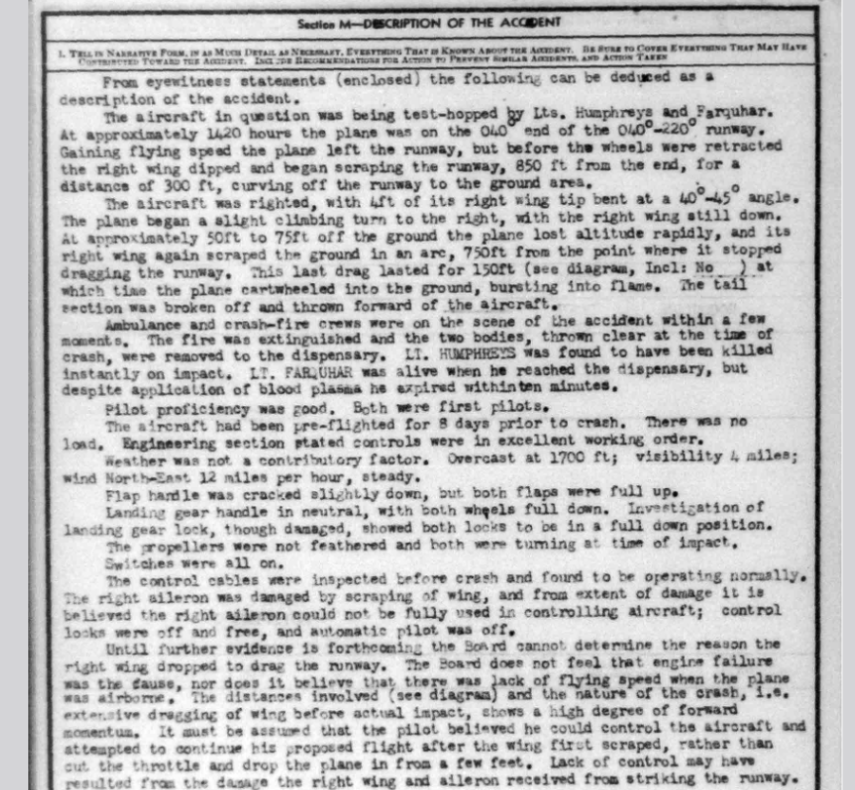


The Captain poor young Man. He took some finding for his name is widely miss-spelt.
https://www.findagrave.com/memorial/...ld-e-humpherys
The 2nd Pilot is interred in the American Cemetery at Madingley, Cambridge.
https://www.findagrave.com/memorial/...erson-farquhar



From the ATC Witness Statement I've assumed (but cannot be sure) that the C-47 commenced its take-off run on R/W 22 from the intersection with R/W 27 which would have given them approximately 3000 ft of runway. It would seem to have been a flap-less take-off which is not uncommon on the C-47. There was a tail-wind of 12 mph.which appears to be of no significance to the investigators.
I've scaled and marked the two impact points where the starboard wing contacted the ground. (A very poor quality sketch map was made on the spot but will not reproduce well).
There were quite a few witnesses - all in an area around the hangars and pan north-east of the Control Tower which I've marked in green.

The Controller remarks that the aircraft appeared to be moving down the the runway pretty slowly - this observation is echoed by another witness. However it could be that they were more accustomed to seeing C-47s moving more rapidly at that point because those aircraft would have commenced take off at the start of R/W 22 and not, as I've assumed in this case, from the intersection.


First Impact Point


Second Impact Point





The Captain poor young Man. He took some finding for his name is widely miss-spelt.
https://www.findagrave.com/memorial/...ld-e-humpherys
The 2nd Pilot is interred in the American Cemetery at Madingley, Cambridge.
https://www.findagrave.com/memorial/...erson-farquhar
Last edited by OUAQUKGF Ops; 22nd Feb 2024 at 09:24.
An interesting video here on DC3 Handling Characteristics. In the Bovingdon Accident Report the investigators were unable on the information available to them to come to a conclusion as to the cause of the initial wing drop which resulted in significant damage to the wing. One inexperienced pilot in the case of Bluebonnet Belle - not so in the Bovingdon accident.
Last edited by OUAQUKGF Ops; 22nd Feb 2024 at 11:46. Reason: Re-write
Curious that experienced pilots would permit an aircraft to drag its wing along the ground for such an extended distance (let alone at all!).
Assuming an absence of weather conditions to explain such a thing and while I realise there are two reports (one a priori) stating the 'control column' was correctly rigged, I am reminded of the Avro Tudor II crash that killed Roy Chadwick and others - because of miss-rigged cables.
Although it wouldn't, arguably, have as much effect as a miss-rigged aileron I note there was no statement about the rudder cables ... either way, that it crashed, on an otherwise benign day, directly after new cables were rigged is highly suggestive of control issues to me...
FP.
Assuming an absence of weather conditions to explain such a thing and while I realise there are two reports (one a priori) stating the 'control column' was correctly rigged, I am reminded of the Avro Tudor II crash that killed Roy Chadwick and others - because of miss-rigged cables.
Although it wouldn't, arguably, have as much effect as a miss-rigged aileron I note there was no statement about the rudder cables ... either way, that it crashed, on an otherwise benign day, directly after new cables were rigged is highly suggestive of control issues to me...
FP.
FP - I've had a look through the documentation to see if there are any technical forms which would throw any light on previous defects on this particular aircraft but there are none. Sometimes one gets lucky and sometimes one does not on these salvaged documents. My gut feeling was and I think remains that this was some form of technical problem. Slightly higher up the Chain of Command I found this from 10th May 1946.

Note remark on take-off speed. Is tail-wind (10kts) relevant? Nasty situation with the end of the runway coming up - the wing dropped with 850ft of runway remaining. (I'm no pilot - I had to go around three times on my second solo at Luton). Commencing take-off it would seem that the tail-wheel came up normally before the aircraft was abeam of the Control Tower. Out of interest the image below shows a C-47, having run about 1,900 ft from the start of RW 22, at a point thereabouts where I believe the doomed aircraft commenced its take-off run. The matter for the moment remains a mystery. Any imput by ex Dak pilots, Old Bovingdon Hands or indeed anybody would be welcome.
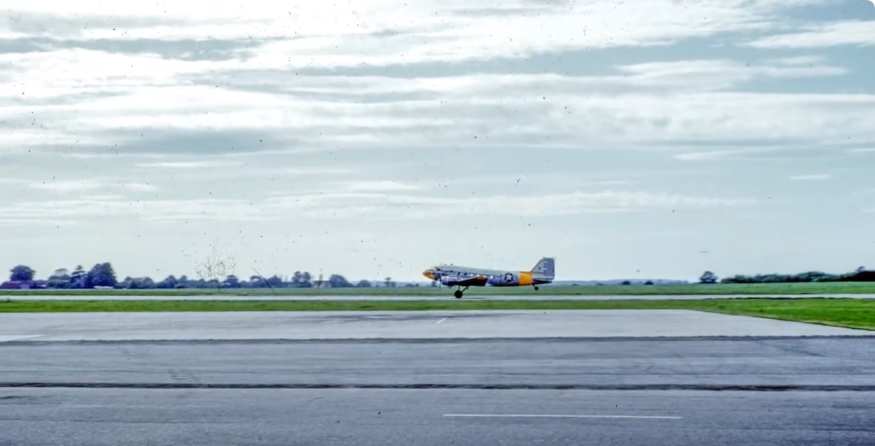
(Bert Friedland)

Note remark on take-off speed. Is tail-wind (10kts) relevant? Nasty situation with the end of the runway coming up - the wing dropped with 850ft of runway remaining. (I'm no pilot - I had to go around three times on my second solo at Luton). Commencing take-off it would seem that the tail-wheel came up normally before the aircraft was abeam of the Control Tower. Out of interest the image below shows a C-47, having run about 1,900 ft from the start of RW 22, at a point thereabouts where I believe the doomed aircraft commenced its take-off run. The matter for the moment remains a mystery. Any imput by ex Dak pilots, Old Bovingdon Hands or indeed anybody would be welcome.

(Bert Friedland)
Last edited by OUAQUKGF Ops; 23rd Feb 2024 at 22:31. Reason: Tidying Up
Thanks for the followup. It's very sad that the pilots weren't able to report their actual experience, but it would seem to me - as is often the case - the simplest explanation is most likely.
Thus giiven the recent servicing and cable change I'd have thought an issue due to this would be the #1 contender.
However it's possible they were simply too slow and stalled at low level, although their experience would suggest this less likely. I am C-47 rated and can say that that they're a pretty forgiving machine, and that 10kts of tailwind, although perhaps not ideal, shouldn't be an issue properly flown. I have no experience at all of Bovingdon though, and should really study the relevant detail before saying anything further, but I guess it's possible they didn't look at the ASI for some reason (or it was malfunctioning) and they thought they were faster than they actually were.
Just to explain the latter (and apologies if you know this already); when you've some experience driving a car, after a while you get used to gauging your speed by external objects and/or the ground passing by, not the speedometer. To some extent it's the same with an aircraft on a takeoff run, however it's the aircraft speed relevant to the air mass that's important for lift, not the ground. If there's a 10kt tailwind then you will need to be doing roughly 10kts more across the ground to achieve the same lift than you might in still air (all other things being equal). If you weren't aware of that and were gauging your velocity solely with respect to the ground then you could end up in trouble, although I can only reiterate that I'd have thought this the less likely scenario given the particular aircraft and crew experience.
FP.
Thus giiven the recent servicing and cable change I'd have thought an issue due to this would be the #1 contender.
However it's possible they were simply too slow and stalled at low level, although their experience would suggest this less likely. I am C-47 rated and can say that that they're a pretty forgiving machine, and that 10kts of tailwind, although perhaps not ideal, shouldn't be an issue properly flown. I have no experience at all of Bovingdon though, and should really study the relevant detail before saying anything further, but I guess it's possible they didn't look at the ASI for some reason (or it was malfunctioning) and they thought they were faster than they actually were.
Just to explain the latter (and apologies if you know this already); when you've some experience driving a car, after a while you get used to gauging your speed by external objects and/or the ground passing by, not the speedometer. To some extent it's the same with an aircraft on a takeoff run, however it's the aircraft speed relevant to the air mass that's important for lift, not the ground. If there's a 10kt tailwind then you will need to be doing roughly 10kts more across the ground to achieve the same lift than you might in still air (all other things being equal). If you weren't aware of that and were gauging your velocity solely with respect to the ground then you could end up in trouble, although I can only reiterate that I'd have thought this the less likely scenario given the particular aircraft and crew experience.
FP.

(William Schneider)
Very many thanks FP - most interesting to hear it from the Horse's Mouth. I thought you might like this image of the threshold of 04 - you can just make out the threshold designator. I've highlighted the approximate point at which the C-47 left the runway which has a slight incline. As always apologies for poor quality of my 'borrowed' image ! Regards OPS.
I've looked for 04 Threshold Images but nothing really to be found - these are Mosquito stills from '633 Squadron'




Above - C-47 Starboard Wing dropped at about this point

C-47 left runway at about this point.
Last edited by OUAQUKGF Ops; 26th Feb 2024 at 11:31. Reason: Mosquito images.
Interesting to see that slope, although as you say they were likely airborne thereabouts so it may not have had much input into what happened.
I should say that this particular horse, while rated, is low time on the C-47, so I'd certainly bow to greater experience! However I have studied the DC3/C-47 in some depth and am reminded of an incident a year or so earlier in which one lost 14ft of its port wing and was able to be flown successfully to a landing. Thus, although there could well be other mechanical reasons why control was ultimately lost, in this case I'm disinclined to take the view that a few feet of bent wingtip would be sufficient in itself.
That said they are known for a somewhat nasty wingdrop on stall when under power, and while that is usually portside the bent wingtip and other factors may have altered that characteristic, particularly once they'd got out of ground effect. I mention this because the last sentence or two of the report suggests the pilots (while in ground effect) may have thought they could control the machine and chose to fly it, rather than close the throttles and stop. With just a few hundred feet of runway remaining such a decision seems reasonable, but once fully airborne they could well have found the situation somewhat different - especially if there were control issues, either due to some rigging problem or as a result of the wing damage.
FYI here's a photograph of NZ3501, 21st March 1945, showing the damage it sustained as a result of collision, yet was still flyable. The photograph appears in DC3 Southern Skies Pioneer by Brian Lockstone and Paul Harrison (ISBN 1 86941 390 3) but this image is cropped and lightly enhanced from www.airhistory.net:

FP.
I should say that this particular horse, while rated, is low time on the C-47, so I'd certainly bow to greater experience! However I have studied the DC3/C-47 in some depth and am reminded of an incident a year or so earlier in which one lost 14ft of its port wing and was able to be flown successfully to a landing. Thus, although there could well be other mechanical reasons why control was ultimately lost, in this case I'm disinclined to take the view that a few feet of bent wingtip would be sufficient in itself.
That said they are known for a somewhat nasty wingdrop on stall when under power, and while that is usually portside the bent wingtip and other factors may have altered that characteristic, particularly once they'd got out of ground effect. I mention this because the last sentence or two of the report suggests the pilots (while in ground effect) may have thought they could control the machine and chose to fly it, rather than close the throttles and stop. With just a few hundred feet of runway remaining such a decision seems reasonable, but once fully airborne they could well have found the situation somewhat different - especially if there were control issues, either due to some rigging problem or as a result of the wing damage.
FYI here's a photograph of NZ3501, 21st March 1945, showing the damage it sustained as a result of collision, yet was still flyable. The photograph appears in DC3 Southern Skies Pioneer by Brian Lockstone and Paul Harrison (ISBN 1 86941 390 3) but this image is cropped and lightly enhanced from www.airhistory.net:

FP.
Join Date: Mar 2024
Location: Berkshire
Posts: 2
Likes: 0
Received 0 Likes
on
0 Posts
Ben Newman retired shortly before I started my training ; Phil Plows was CFI. To avoid thread creep, I flew with Mike on my introductory lessons and with Paul just pre solo (Jacko did the solo checks on Pauls recommendation).
My log book reveals the first det to Bovingdon was on 21 Jun '65 and my soaring took place on the next det (we took the aircraft by road this time) on 19 Sep '65. My log book records the day before I'd flown an aerobatic trip with Paul at Bovingdon in Sedbergh XN150!!
My log book reveals the first det to Bovingdon was on 21 Jun '65 and my soaring took place on the next det (we took the aircraft by road this time) on 19 Sep '65. My log book records the day before I'd flown an aerobatic trip with Paul at Bovingdon in Sedbergh XN150!!
I'm Paul Duncombe's daughter. It's been fun to read some of these posts and memories.
If anyone has more stories about my Dad, please do get in touch. Id love to hear them.
Kind regards
Jen
Very many thanks FP - most interesting to hear it from the Horse's Mouth. I thought you might like this image of the threshold of 04 - you can just make out the threshold designator. I've highlighted the approximate point at which the C-47 left the runway which has a slight incline. As always apologies for poor quality of my 'borrowed' image ! Regards OPS.
I've looked for 04 Threshold Images but nothing really to be found - these are Mosquito stills from '633 Squadron'
Yes I think you can also at one stage in ' 633 Squadron ' glimpse day glow on the tail of a Varsity. As far as I can remember in the closing sequences of ' Mosquito Squadron ' a Fairchild Packet C-119 is just getting airborne in the background. I don't know if the following sequence was fully shown in ' The War Lover ' but it includes a rash of Ansons and the only image we have so far of a KC-97 at Bovingdon.


Plucked from the ether
The last of the photographs taken by John Young at Bovingdon's Open House May 17th 1958 are of a Convair C-131A (525790)

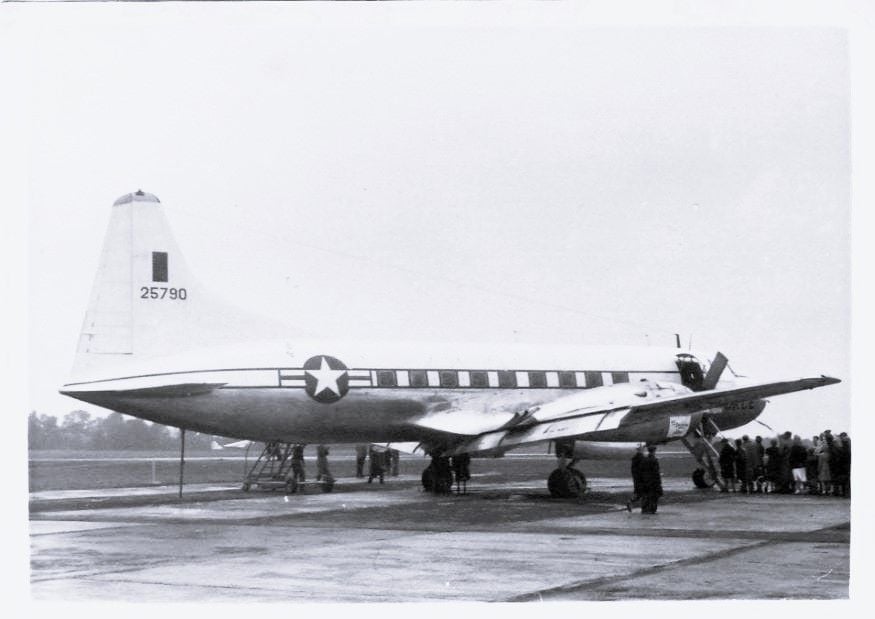
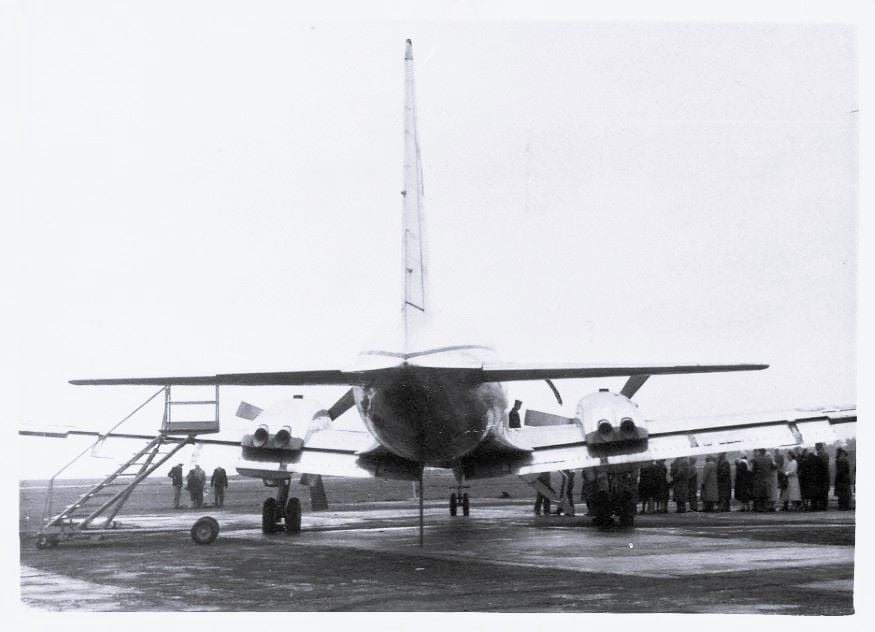
Of course you can't beat a really good photo of an aeroplane in flight. Taken by Ralf Manteuful, here is the same Samaritan on short finals at Templehof, Berlin in June 1961.

Credit as captioned with thanks.
I came across some negatives of hangared Ansons taken at Bovingdon on 15th June 1968 - this was shortly before their farewell flypast on 28th June 1968. At much the same time a start was being made on the filming of 'Mosquito Squadron'. PPRuNer Old Photo.Fanatic has very kindly digitalized the negatives - many thanks.

On retirement TX 227 was painted up for her part in 'Mosquito Squadron'

Another 'Paint Job' followed when TX 227 together with VV 958 was purchased by Mercy Missions from C.Bilson Ltd (Scrap Dealers) for work in Biafra, TX 227 being registered G-AWMH.

Jersey Post
The two Ansons departed from Bovingdon for Guernsey on the first leg of their journey to Africa on 5th August 1968 however adverse weather and low cloud forced a diversion to Jersey (above) where the aeroplanes were grounded for four days due to poor weather. With its final destination as Sao Tome G-AWMH succumbed to an engine failure followed by a forced landing when damage was sustained at Port Etienne, Mauritania on August 16th 1968. After some considerable time the Anson was repaired but never proceeded to Biafra crashing in unknown circumstances in Liberia on June 20th 1969.

Immaculate - maintained by Shorts and scrapped at Bovingdon later that year.
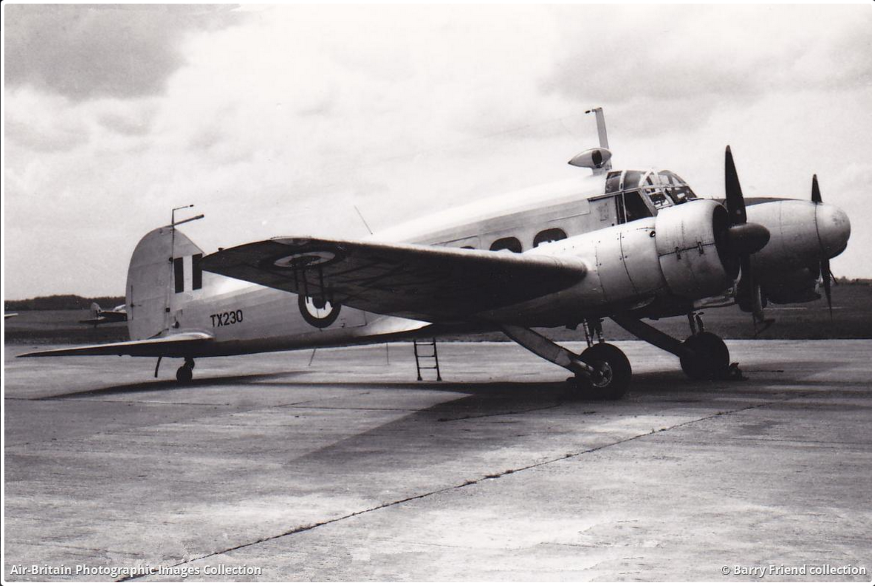
Early Sixties. Thought to have been photographed at Bovingdon. Image Barry Friend with thanks.

Scrapped at Bovingdon later that year.
.
Early Sixties, location unknown. Image Barry Friend with thanks.

This Anson having been kept as a standby for Mercy Missions was sold to John Hawke and registered as G-AWSB on October 21st 1968. That registration was cancelled on November 5th 1968 and the aeroplane was flown to America where it was registered as N7522. The Deputy SATCO of Bovingdon 1967-69 relates on page 2 of this thread ' Another Anson set off in the hands of a PPL accompanied by an air hostess from Luton for the States and on the first leg to Prestwick ended up in Ireland. I don't know if they ever crossed the real pond.'
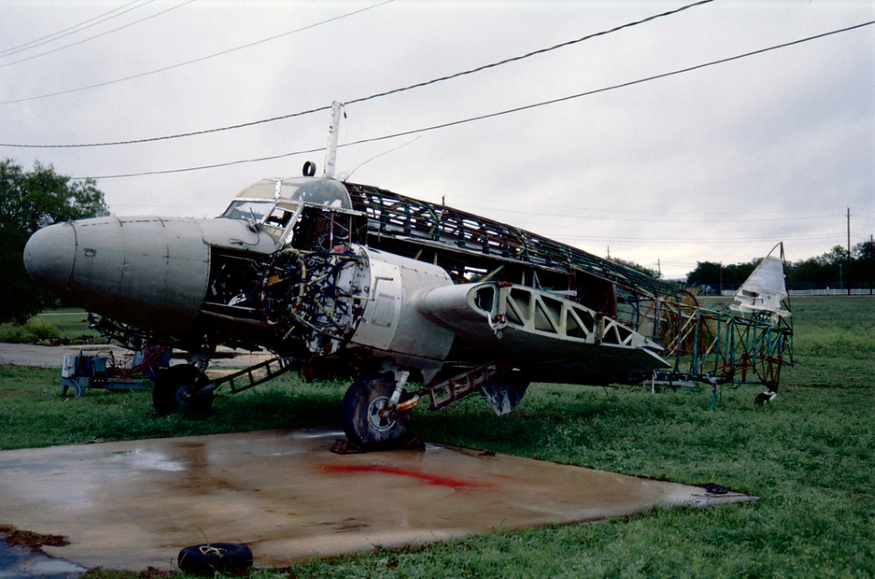
Image Crusader 752
N7522 at Georgetown,Texas in 1998. It is rumoured that what remains of this Anson was offered up at $US12,000 for restoration in 2023.



Of course you can't beat a really good photo of an aeroplane in flight. Taken by Ralf Manteuful, here is the same Samaritan on short finals at Templehof, Berlin in June 1961.

Credit as captioned with thanks.
I came across some negatives of hangared Ansons taken at Bovingdon on 15th June 1968 - this was shortly before their farewell flypast on 28th June 1968. At much the same time a start was being made on the filming of 'Mosquito Squadron'. PPRuNer Old Photo.Fanatic has very kindly digitalized the negatives - many thanks.

On retirement TX 227 was painted up for her part in 'Mosquito Squadron'

Another 'Paint Job' followed when TX 227 together with VV 958 was purchased by Mercy Missions from C.Bilson Ltd (Scrap Dealers) for work in Biafra, TX 227 being registered G-AWMH.

Jersey Post
The two Ansons departed from Bovingdon for Guernsey on the first leg of their journey to Africa on 5th August 1968 however adverse weather and low cloud forced a diversion to Jersey (above) where the aeroplanes were grounded for four days due to poor weather. With its final destination as Sao Tome G-AWMH succumbed to an engine failure followed by a forced landing when damage was sustained at Port Etienne, Mauritania on August 16th 1968. After some considerable time the Anson was repaired but never proceeded to Biafra crashing in unknown circumstances in Liberia on June 20th 1969.

Immaculate - maintained by Shorts and scrapped at Bovingdon later that year.

Early Sixties. Thought to have been photographed at Bovingdon. Image Barry Friend with thanks.

Scrapped at Bovingdon later that year.
.

Early Sixties, location unknown. Image Barry Friend with thanks.

This Anson having been kept as a standby for Mercy Missions was sold to John Hawke and registered as G-AWSB on October 21st 1968. That registration was cancelled on November 5th 1968 and the aeroplane was flown to America where it was registered as N7522. The Deputy SATCO of Bovingdon 1967-69 relates on page 2 of this thread ' Another Anson set off in the hands of a PPL accompanied by an air hostess from Luton for the States and on the first leg to Prestwick ended up in Ireland. I don't know if they ever crossed the real pond.'

Image Crusader 752
N7522 at Georgetown,Texas in 1998. It is rumoured that what remains of this Anson was offered up at $US12,000 for restoration in 2023.
Last edited by OUAQUKGF Ops; 12th Mar 2024 at 19:54. Reason: tidying up.
I had two WO (ATC) on my squadron (2204 Chesham Sqdn) and both worked for Shorts at Bovingdon unitl it closed.
Didn't one of the Biafran Ansons have to drop in at Blackbushe on the way south?
Didn't one of the Biafran Ansons have to drop in at Blackbushe on the way south?
Quoting from that excellent book 'Shadows' by Michael Draper (Co-pilot G-AWMG) the initial routing and times for the Ansons were:
G-AWMG 5.8.68 Bovingdon - Jersey 1300-1440 1.40 Diversion from Guernsey due wx.
9.8.68 Jersey - Bilbao 1640-2010 3.30 In formation with G-AWMH.
G-AWMH 5.8.68 Bovingdon-Jersey 1305-1445 1.40 Diversion from Guernsey due wx.
9.8.68 Jersey - Bilbao 1640-2010 3.30 in formation with G-AWMG.
'After landing at Bilbao the starboard main undercarriage of G-AWMH was found to have sustained damage. Closer inspection revealed that a wheel rim had fractured, possibly as a result of the landing at Jersey in poor conditions several days beforehand. Another enforced overnight stay for both aircraft allowed time to organise replacement parts to be ferried down from Bovingdon but in the meantime it was agreed that G-AWMG would ply on ahead.' (That Anson departed Bilbao 10.8.68 routing to Seville onwards to Casablanca and finally arriving Sao Tome on 16.8.68. G-AWMH departed Bilbao 12.8.68 and after further alarms and diversions force-landed at Port-Etienne 16.8.68.)
Source: 'Shadows' by Michael I. Draper. Hikoki Publications 1999.
G-AWMG 5.8.68 Bovingdon - Jersey 1300-1440 1.40 Diversion from Guernsey due wx.
9.8.68 Jersey - Bilbao 1640-2010 3.30 In formation with G-AWMH.
G-AWMH 5.8.68 Bovingdon-Jersey 1305-1445 1.40 Diversion from Guernsey due wx.
9.8.68 Jersey - Bilbao 1640-2010 3.30 in formation with G-AWMG.
'After landing at Bilbao the starboard main undercarriage of G-AWMH was found to have sustained damage. Closer inspection revealed that a wheel rim had fractured, possibly as a result of the landing at Jersey in poor conditions several days beforehand. Another enforced overnight stay for both aircraft allowed time to organise replacement parts to be ferried down from Bovingdon but in the meantime it was agreed that G-AWMG would ply on ahead.' (That Anson departed Bilbao 10.8.68 routing to Seville onwards to Casablanca and finally arriving Sao Tome on 16.8.68. G-AWMH departed Bilbao 12.8.68 and after further alarms and diversions force-landed at Port-Etienne 16.8.68.)
Source: 'Shadows' by Michael I. Draper. Hikoki Publications 1999.
Last edited by OUAQUKGF Ops; 16th Mar 2024 at 19:00.
A short flight back in time
The loss of Gloster Meteor F.4 RA452 based at Bovingdon with RAF Fighter Command Communications Squadron - 19th April 1949.
Well to start off with I have looked high and low for an image of this particular aircraft but like many Meteors it had a fairly short operational life so photographs if any are few and far between.
Making do then with an image of another Meteor F.4........
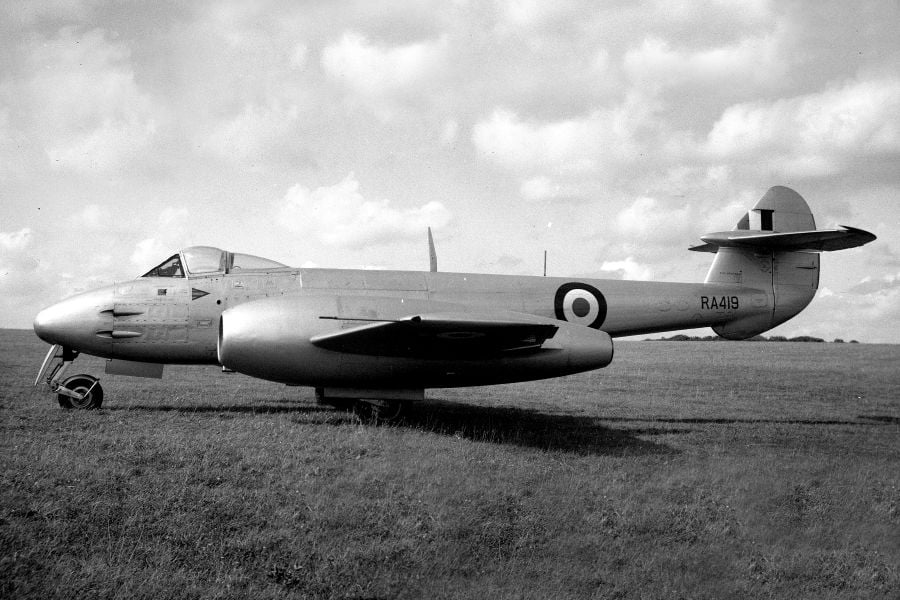
Location unknown. This F.4 was with 209 AFS and was struck off charge after a heavy landing Weston Zoyland 13 May 1954.
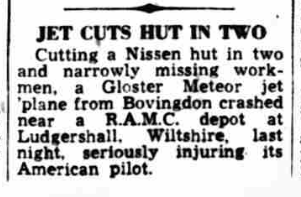
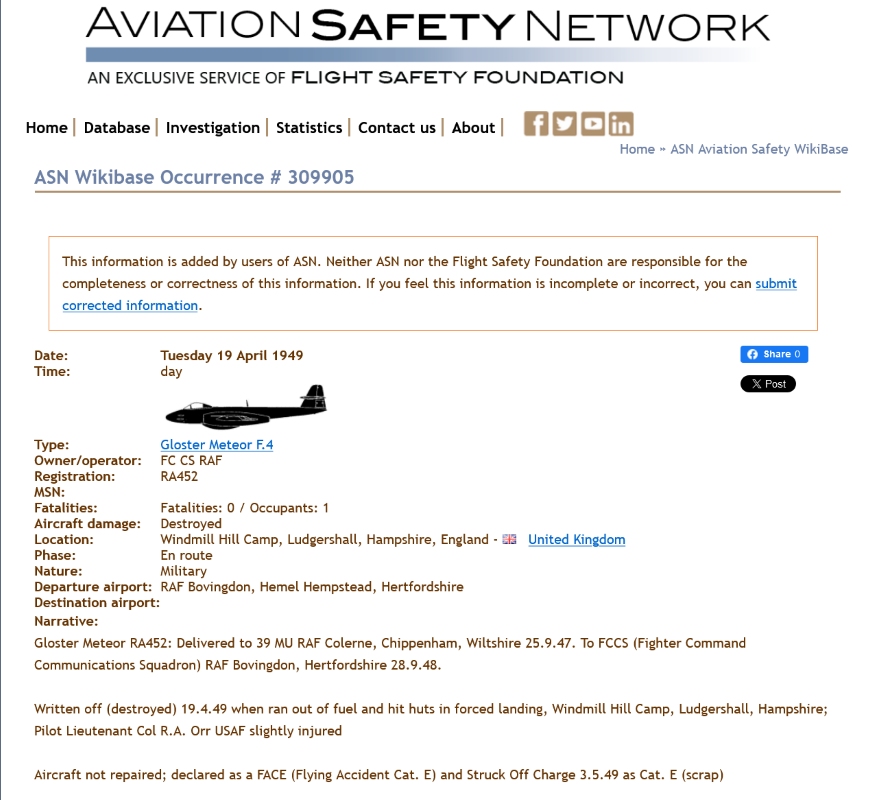
Ludgershall is actually in Wiltshire. The American Pilot was believed to have been seriously injured, contra to the above. The Americans categorized this accident as 'CRLoG' (Crash Landing Out of Gas). I have not seen the accident report. A Meteor F.4 would have had a fuel endurance of less than one hour.

Bovingdon to Ludgershall

Image Chris Talbot Geograph. Above - the former Defence Medical Equipment Depot on the outskirts of Ludgershall photographed in 2011.
Quite where in the environs of Ludgershall Col Orr came to rest is, after the passage of time, perhaps unknown to most, myself included. More recently Army Depots, of which there were several about the town, have been demolished or re-developed.

Here we have a reference to the Meteor forced landing on the Downs.

Members of Birmingham University OTC resting on the Downs below Windmill Hill in 1912. I wonder how many survived The War which would shortly be upon them ?
The view is ESE towards Ludgershall. The railway is the branch line to Tidworth from Ludgershall opened in 1901 and closed in 1963. It was primarily built to service the Military at Tidworth.

In the lee of the wood on Windmill Hill. Both the above images courtesy of Terry Carter on The Great War Forum.

Windmill Hill to WNW from the outskirts of Ludgershall.


Note franked stamp.
I know not much about Meteors but I take the liberty of transcribing this from the UK Defence Forum:
In May 1951, it was reported that the Meteor 4's tail unit lost half its strength when the skin tore, the skin tearing was found to originate round rivet holes, access panels or discontinuous stringers (stress risers). A total of 890 Meteors were lost in RAF service (145 of these crashes occurred in 1953 alone), resulting in the deaths of 450 pilots. Contributory factors in the number of crashes were high fuel consumption and consequent short flight endurance, causing pilots to run out of fuel, and difficult handling with one engine out due to the widely set engines. The casualty rate was exacerbated by the lack of ejection seats in early series Meteors, the high speed that the aircraft was capable of meant that during the bailing out process, pilots were typically subject to high G Forces hindering movement and with the effect of slipstream winds there was also a greater likelihood of the pilot striking the horizontal tailplane. Ejection seats would be fitted in the later F.8, FR.9, PR.10 and some experimental Meteors. The difficulty of bailing out of the Meteor had been noted by pilots during development, reporting several contributing design factors such as the limited size and relative position of the cockpit to the rest of the aircraft and difficulty in using the two-lever jettisonable hood mechanism.
That said I'm sure that many hundreds if not thousands of pilots enjoyed flying these sometimes challenging aeroplanes.
For more about Army Camps in Wiltshire:How Military Camps saved some Wiltshire villages from extinction | Wiltshire at War
Well to start off with I have looked high and low for an image of this particular aircraft but like many Meteors it had a fairly short operational life so photographs if any are few and far between.
Making do then with an image of another Meteor F.4........

Location unknown. This F.4 was with 209 AFS and was struck off charge after a heavy landing Weston Zoyland 13 May 1954.


Ludgershall is actually in Wiltshire. The American Pilot was believed to have been seriously injured, contra to the above. The Americans categorized this accident as 'CRLoG' (Crash Landing Out of Gas). I have not seen the accident report. A Meteor F.4 would have had a fuel endurance of less than one hour.

Bovingdon to Ludgershall

Image Chris Talbot Geograph. Above - the former Defence Medical Equipment Depot on the outskirts of Ludgershall photographed in 2011.
Quite where in the environs of Ludgershall Col Orr came to rest is, after the passage of time, perhaps unknown to most, myself included. More recently Army Depots, of which there were several about the town, have been demolished or re-developed.

Here we have a reference to the Meteor forced landing on the Downs.

Members of Birmingham University OTC resting on the Downs below Windmill Hill in 1912. I wonder how many survived The War which would shortly be upon them ?
The view is ESE towards Ludgershall. The railway is the branch line to Tidworth from Ludgershall opened in 1901 and closed in 1963. It was primarily built to service the Military at Tidworth.

In the lee of the wood on Windmill Hill. Both the above images courtesy of Terry Carter on The Great War Forum.

Windmill Hill to WNW from the outskirts of Ludgershall.


Note franked stamp.
I know not much about Meteors but I take the liberty of transcribing this from the UK Defence Forum:
In May 1951, it was reported that the Meteor 4's tail unit lost half its strength when the skin tore, the skin tearing was found to originate round rivet holes, access panels or discontinuous stringers (stress risers). A total of 890 Meteors were lost in RAF service (145 of these crashes occurred in 1953 alone), resulting in the deaths of 450 pilots. Contributory factors in the number of crashes were high fuel consumption and consequent short flight endurance, causing pilots to run out of fuel, and difficult handling with one engine out due to the widely set engines. The casualty rate was exacerbated by the lack of ejection seats in early series Meteors, the high speed that the aircraft was capable of meant that during the bailing out process, pilots were typically subject to high G Forces hindering movement and with the effect of slipstream winds there was also a greater likelihood of the pilot striking the horizontal tailplane. Ejection seats would be fitted in the later F.8, FR.9, PR.10 and some experimental Meteors. The difficulty of bailing out of the Meteor had been noted by pilots during development, reporting several contributing design factors such as the limited size and relative position of the cockpit to the rest of the aircraft and difficulty in using the two-lever jettisonable hood mechanism.
That said I'm sure that many hundreds if not thousands of pilots enjoyed flying these sometimes challenging aeroplanes.
For more about Army Camps in Wiltshire:How Military Camps saved some Wiltshire villages from extinction | Wiltshire at War
Last edited by OUAQUKGF Ops; 18th Mar 2024 at 13:36.
When I was on Coastal Com at Bovingdon in 1961/2 Fighter Com had a Very nice Meteor NF 14. Having flown the Meteor 7 and 8 at Nicosia I tried to have a go with the Fighter Com Meteor, but failed,even though they were happy to let me fly their Ansons, including several trips to Jersey!.



